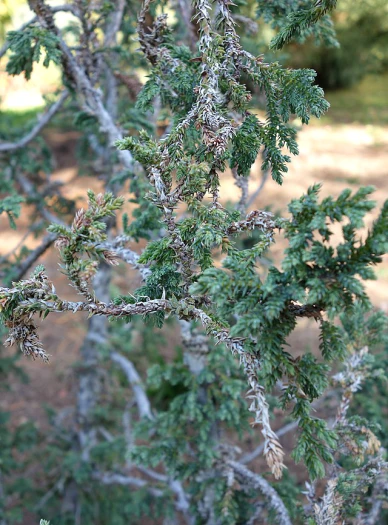Ping’s Juniper
(Juniperus pingii)
Ping’s Juniper (Juniperus pingii)
/
/

Daderot
CC0
Image By:
Daderot
Recorded By:
Copyright:
CC0
Copyright Notice:
Photo by: Daderot | License Type: CC0 | License URL: http://creativecommons.org/licenses/by-sa/3.0/ | Uploader: Daderot | Publisher: Wikimedia Commons |



Estimated Native Range
Climate Requirements for Draper, Utah
| This Plant | Your Site | Plant Suitability for Your Location | ||
|---|---|---|---|---|
| • Precipitation | 6" - 65" | 18" | Your precipitation may be insufficient for this plant. Irrigate N" / year. | Irrigate N" / year |
| • High Temp. | 53°F - 90°F | 91°F | Your summers may be too hot for this plant. | Too hot |
| • Low Temp. | -7°F - 41°F | 18°F | Your winter temperatures are normal for this plant | Excellent |
This plant should grow well at your location with about N inches per year (Y minutes per month) of irrigation.
Summary
Juniperus pingii, commonly known as Ping’s Juniper, is a coniferous evergreen shrub or small tree native to alpine and subalpine zones in China, including the Hengduan Mountains and the Tibetan Plateau. It exhibits a variable growth habit, often appearing as a prostrate shrub, but it can also reach up to 20 feet tall when growing as a tree. Ping’s Juniper is hardy to USDA zone 7 and was named in honor of Chinese botanist Wan Chun Cheng. This species typically has a slow growth rate and can be found in rocky, well-drained soils in its native habitat.
Ping’s Juniper is valued for its aesthetic qualities and adaptability in cultivation. It is particularly noted for its ability to produce a proportional miniature version of the full-sized tree, making it a favorite for bonsai. The plant’s compact growth habit and tolerance for pruning are advantageous for creating detailed, miniature landscapes. In garden settings, it is used in rock gardens, as an ornamental plant, and for creating naturalistic alpine compositions. It requires well-drained soils and thrives in full sun, but it can also tolerate light shade. While generally low-maintenance, it can be susceptible to fungal diseases if conditions are too moist or if there is poor air circulation.CC BY-SA 4.0
Ping’s Juniper is valued for its aesthetic qualities and adaptability in cultivation. It is particularly noted for its ability to produce a proportional miniature version of the full-sized tree, making it a favorite for bonsai. The plant’s compact growth habit and tolerance for pruning are advantageous for creating detailed, miniature landscapes. In garden settings, it is used in rock gardens, as an ornamental plant, and for creating naturalistic alpine compositions. It requires well-drained soils and thrives in full sun, but it can also tolerate light shade. While generally low-maintenance, it can be susceptible to fungal diseases if conditions are too moist or if there is poor air circulation.CC BY-SA 4.0
Plant Description
- Plant Type: Tree, Shrub
- Height: 3-15 feet
- Width: 2-8 feet
- Growth Rate: Slow
- Flower Color: N/A
- Flowering Season: Non-Flowering
- Leaf Retention: Evergreen
Growth Requirements
- Sun: Full Sun
- Water: Medium, High
- Drainage: Medium, Fast
Common Uses
Deer Resistant, Drought Tolerant, Groundcover, Low Maintenance, Rabbit Resistant, Rock Garden
Natural Habitat
Alpine and subalpine zones in China, including the Hengduan Mountains and the Tibetan Plateau
Other Names
Common Names: Chui Zhi Xiang Bai, Chinese Juniper
Scientific Names: Juniperus pingii
GBIF Accepted Name: Juniperus pingii